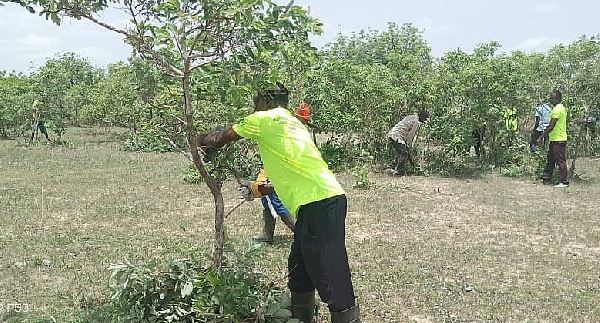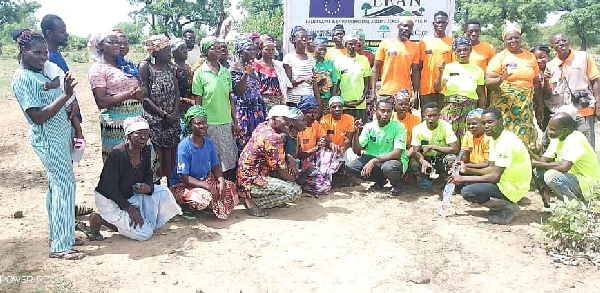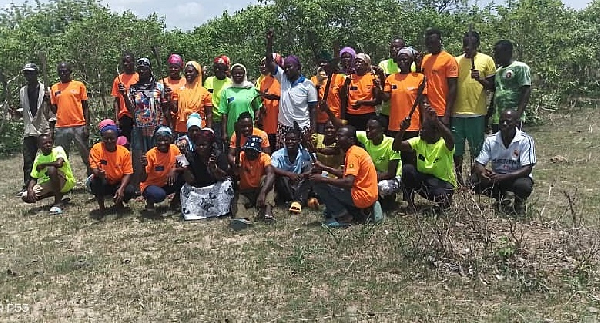It is a known fact that many development partners across Ghana are initiating and implementing various interventions aimed at complementing government’s efforts to achieve the Sustainable Development Goals (SDGs). One such development partners is World Vision, a Non-Governmental Organization (NGO).
World Vision with its partners, Tropenbos Ghana and EcoCare Ghana begun implementing a- four- year project dubbed “Landscapes and Environmental Agility Across the Nation (LEAN) across 25 communities in the Kassena-Nankana West District (KNWD) of the Upper East Region in 2021. The project is expected to end this year, 2025. World Vision is also implementing same project in West Gonja District of the Savannah Region.
Funded by the European Union’s flagship GCCA+ initiative, the project aimed to conserve biodiversity, build climate resilience, and reduce emissions from land-use changes in the savannah, high forest, and transition zones of Ghana as well as helping local farmers to improve their livelihoods. It is also important to state that the project is under the European Union’s Action on Climate Change Resilience and Landscape Restoration.

Implementing the project in the beneficiary communities, World Vision and its partners deployed Integrated Landscape Management (ILM) model as a core strategy. This multi-pronged approach is directly aligned with environmental restoration with economic empowerment, contributing to the attainment of the Sustainable Development Goals (SDGs), The initiative which demonstrate that local action can yield global impact, marks a shift from crisis-driven resource use to a model of integrated and sustainable development.
The model which recognizes that environmental sustainability must be deeply interconnected with the economic wellbeing of those living on the land, since its inception, had engaged over 6,000 smallholder farmers in efforts to span forest protection, climate-smart agriculture, inclusive landscape governance, and the promotion of viable alternative livelihoods.
During a monitoring visit to the beneficiary’s communities in the KNWD, conducted by World Vision’s staff, involving the media, I was amazed to see the greening nature of the environment. In fact, one of the project’s most remarkable environmental achievements has been the restoration of over 284 hectares of degraded land through sustainable land use practices, including Farmer Managed Natural Regeneration (FMNR). These efforts, concentrated in 22 communities, have reversed widespread land degradation, improved soil fertility, and rejuvenated vegetation cover.
In areas such as Navio-Samwo and Kalivio Gugoro, previously barren lands, are now regenerating, supporting emerging ecosystems and reducing greenhouse gas emissions. This positive result was achieved as a result of the project training over 1,000 community members, equally divided between men and women, as fire volunteers and lead farmers. These volunteers were equipped to prevent bushfires, being one of the biggest threats to reforested landscapes. Again, as a result of this training, the beneficiaries restored lands with improved techniques and vigilance in protecting the environment from bush fires.

It is also very critical to state that the project goes beyond just environmental recovery to addressing the root causes of degradation: poverty and lack of economic opportunity. It is well established that in rural areas in Ghana, economic necessity often forces people to rely on unsustainable practices such as cutting down trees for charcoal production, overgrazing, and slash-and-burn farming. Studies, including a 2019 report conducted by the Centre for Climate Change and Sustainability Studies at the University of Ghana and a 2020 IUCN assessment, confirm that deforestation and resource depletion in northern Ghana are primarily driven by economic desperation, not choice.
Particularly concerning is the depletion of shea and other native trees for charcoal production, which accelerates desertification and eliminates long-term income potential. To counter this, the Project introduced climate-resilient, income-generating activities (IGAs) that offer dignified alternatives to environmentally harmful practices. For example, 150 farmers, including persons with disabilities, were supported with 300 small ruminants, mainly goats and sheep. These livestock not only provide a new source of income and nutrition but also serve as a buffer against seasonal income gaps.
Additionally, the project has trained and equipped 100 individuals in beekeeping, providing them with hives, honey-processing equipment, and harvesting gear. These community members can now produce and market honey, a sustainable, high-value product with growing demand. Complementing these efforts is the development of a 1.5-acre dry-season irrigated garden, designed to bolster food security and generate year-round income, especially during periods when agricultural activity typically slows down and charcoal production increases.
Another cornerstone of the project’s ’s success is the Savings for Transformation (S4T) component. In 24 beneficiary communities, sixty (60) S4T groups have been established, directly benefiting over 1,500 men and women. These groups are more than just savings and loan associations.
Members receive training in leadership, entrepreneurship, and financial literacy, helping them to build sustainable businesses and manage their finances effectively. In the first cycle alone, group savings exceeded GH₵647,951, with a total share-out of GH₵1,006,750. Beneficiaries have used this capital to start ventures in areas such as retail, livestock trade, agro-processing, and soap making.
The economic impact of the project is deeply rooted in personal and transformative. For example, Ms Vivian Adawona , a member of the S4T group at the Banyono community ,told me that she took a loan from the S4T to establish a provision store She now pays for her children’s school fees and no longer depends on cutting down trees for charcoal production and selling firewood.
“I took loan from S4T with no interest to establish my provision store. Through this I’m able to earn income to cater for my children in school. I’m most grateful to this intervention. I and my colleagues no longer cut down tee for charcoal production to make income.”
This addresses critical development goals like SDG 1 (No Poverty) and SDG 5 (Gender Equality), and reduces the economic pressures that drive deforestation.
Beyond this income opportunities, the LEAN Project has also tapped into cultural heritage to create livelihoods. In a groundbreaking intervention, the project supported 150 women with traditional weaving looms, allowing them to leverage ancestral skills for economic gains. These looms have revived interest in traditional crafts while creating employment opportunities within the project communities.
For many, weaving has become a dignified alternative to migrating to urban centers for informal labour or engaging in forest exploitation. One beneficiaries from the Navio Samwo community , Ms Benedicta Wugaa, told me how she benefited from the intervention. “The weaving loom given to me has restored my dignity. Apart from getting income I also have four younger women I train. Before then I thought the only means to make money was to travel to Kumasi and Accra to engage in Kayaye which often make us young girls fall into victim of exploitation and sickness. This intervention has reduced the migration of many of us young girls in this community”.
In addition to household-level interventions, the LEAN Project is also strengthening institutional governance for long-term sustainability. In 2023, the project facilitated the creation and official inauguration of the district’s first-ever Landscape Management Board (LMB). This governance body includes representatives from the District Assembly, traditional authorities, and community stakeholders.
The LMB oversees the planning, implementation, and monitoring of environmental restoration initiatives. It has developed land use plans, identified fire-prone areas, and collaborated on the creation of local by-laws to formalize and protect gains from degradation reversal. This ensures transparency, accountability, and local ownership, key ingredients for lasting impact.

The Physical Development Officer of the KNWD, Mr Caesar Adda, who expressed happiness about the project intervention, stated that as a result of the intervention, the incident of rampant bushes in the District have been curbed, adding that through the bottom up approach, community participation had led to the development of proper land use plans for this District.
The LEAN Project Manager, Mr Joseph Yelkabong, explained that the project module’s strength lies in its recognition that sustainable landscapes must be supported by sustainable livelihoods. He stated that project’s model was one the best intervention in restoring degraded and the conservation of biodiversity. He indicated that the intervention was cost effective and the most efficient manner of mitigating climate change.
In conclusion, the time to scale up the LEAN Project to the savannah belts and beyond is now. The LEAN Project has proven that when given the tools, knowledge, and opportunity, rural communities can be become the strongest protectors of their environment and architects of their future. The LEAN Project is more than a set of environmental interventions. It is a holistic model for climate-smart, community-led development. Its results are tangible and measurable, yet its true power lies in its replicability.
With the right support from the Government, donor agencies, NGOs, and international partners, the LEAN Project could be scaled across the savannah belt of Ghana and beyond. It is a cost-effective, inclusive, and community-owned solution capable of accelerating progress across multiple SDGs, from poverty reduction and gender equality to climate action and biodiversity conservation.


